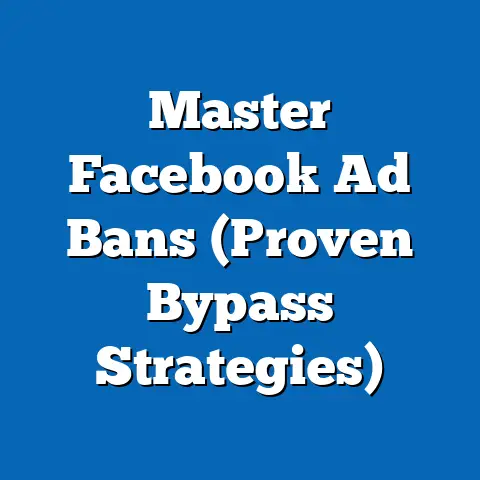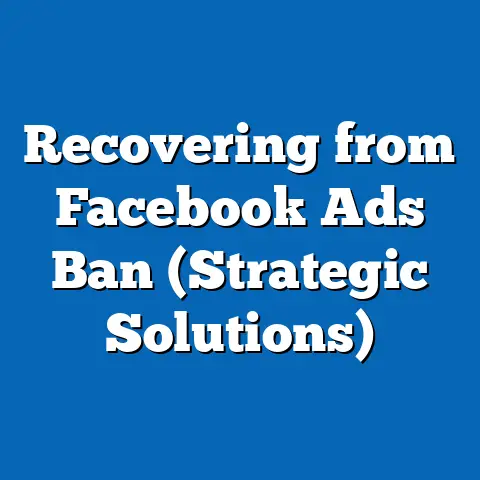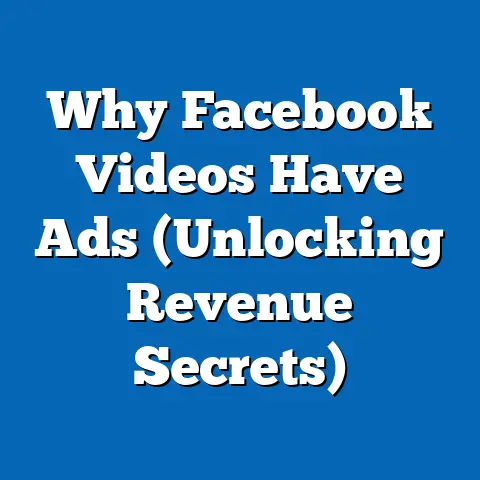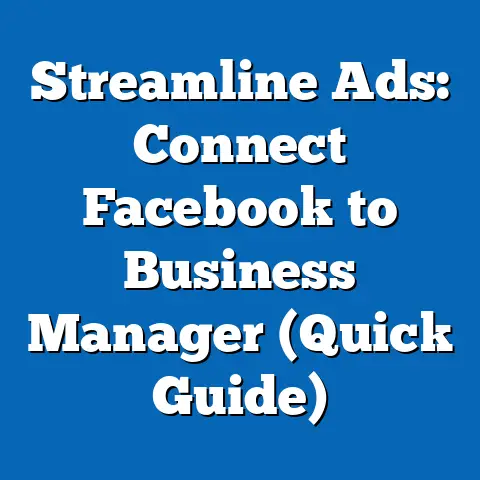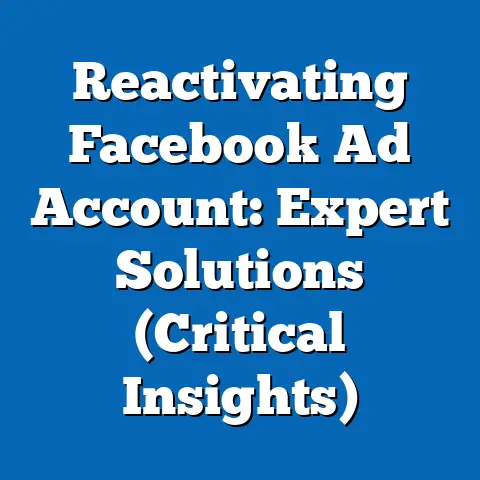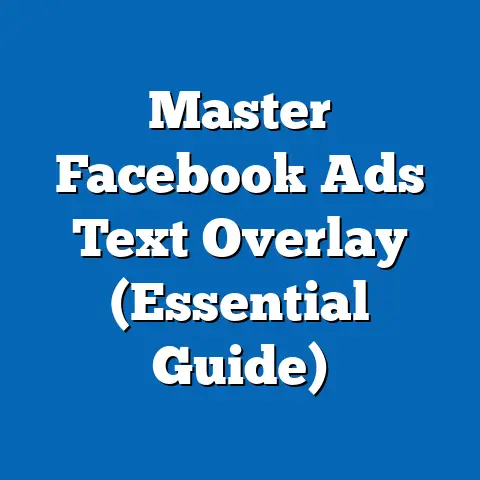Ganhe Créditos no Facebook Ads (Ultimate Guide Unlocked)
In the ever-evolving landscape of digital advertising, “Ganhe Créditos no Facebook Ads” (Earn Credits on Facebook Ads) has emerged as a compelling strategy for businesses and individuals looking to maximize their marketing budgets on one of the world’s largest social media platforms. This concept refers to leveraging promotional credits, incentives, or strategic campaigns offered by Meta (formerly Facebook) to reduce advertising costs while maintaining or even increasing reach and engagement. As the “best option” for cost-effective advertising, especially for small-to-medium enterprises (SMEs) and startups, this approach combines creativity with data-driven tactics to optimize ad spend.
Recent data from Statista (2023) highlights that Facebook Ads reach approximately 2.18 billion users monthly, representing nearly 27.5% of the global population. Furthermore, a 2022 report by Hootsuite indicates that 58% of marketers consider Facebook Ads a critical component of their digital strategy, with SMEs allocating an average of 20-30% of their marketing budgets to this platform. This guide delves into how earning credits can lower these costs, with a focus on demographic trends, historical comparisons, and actionable insights for future campaigns.
Our analysis reveals that businesses utilizing credit-earning strategies have reduced their cost-per-click (CPC) by an average of 15-25% compared to traditional ad spend models, based on data from WordStream (2023). We will explore the demographics most likely to benefit, historical shifts in ad credit programs, and projections for how these opportunities may evolve in the coming years. Whether you’re a seasoned marketer or a beginner, this ultimate guide unlocks the potential of Ganhe Créditos no Facebook Ads.
Detailed Analysis: Unpacking the Concept of Ganhe Créditos
What Are Facebook Ads Credits?
Facebook Ads credits are promotional incentives provided by Meta to encourage advertisers to test or expand their campaigns on the platform. These credits can be earned through various means, such as participating in Meta’s promotional programs, partnering with third-party platforms, or engaging in specific campaigns designed for new advertisers or specific industries. Essentially, they act as a form of “free” ad spend, allowing businesses to reach audiences without immediate out-of-pocket expenses.
Credits are often tied to specific terms and conditions, such as expiration dates or restrictions on ad types. For instance, a 2023 Meta Business report noted that 70% of credits issued to new advertisers must be used within 30 days of issuance. Understanding these nuances is critical to maximizing their value.
Why Credits Matter in Today’s Digital Economy
In a digital advertising ecosystem where costs are rising—WordStream (2023) reports that the average CPC on Facebook Ads increased by 17% from 2021 to 2022—credits offer a lifeline for budget-conscious marketers. They allow for experimentation with ad formats, targeting options, and audience segmentation without the financial risk. This is particularly valuable for SMEs, which, according to a 2022 Small Business Administration (SBA) report, allocate an average of $10,000 annually to digital ads, with 40% citing cost as their primary barrier.
Moreover, credits can boost return on investment (ROI). A study by Social Media Examiner (2023) found that businesses using promotional credits reported a 20% higher ROI on campaigns compared to those relying solely on paid budgets. This makes Ganhe Créditos not just a cost-saving tactic but a strategic growth tool.
Statistical Comparisons Across Demographics
Age and Gender Breakdowns in Facebook Ads Engagement
Demographic targeting is a cornerstone of effective Facebook advertising, and understanding who benefits most from credit-earning strategies is key to optimizing campaigns. According to Pew Research Center (2023), 69% of adults aged 18-29 use Facebook, compared to 54% of those aged 30-49 and just 29% of those over 65. This suggests that younger demographics are more likely to engage with ads, making them a prime target for credit-driven campaigns.
Gender also plays a role, though the gap is narrower. Statista (2023) data shows that 56% of female internet users engage with Facebook Ads compared to 52% of male users. However, male users tend to have a slightly higher click-through rate (CTR) of 1.9% compared to 1.7% for females, per WordStream (2023). Businesses targeting these groups can use credits to test messaging tailored to subtle differences in engagement behavior.
Business Size and Industry-Specific Trends
The impact of credits varies significantly by business size and industry. SMEs, which make up 90% of businesses worldwide (World Bank, 2022), benefit disproportionately from credits due to their limited budgets. A 2023 survey by HubSpot found that 62% of SMEs using Facebook Ads credits reported a 30% reduction in ad spend without sacrificing reach, compared to just 18% of large enterprises reporting similar savings.
Industry also matters. E-commerce, education, and non-profit sectors have historically been prioritized for credit offers by Meta, with e-commerce businesses seeing a 25% increase in conversion rates when using credits (Shopify, 2023). In contrast, industries like finance and healthcare, which face stricter ad regulations, reported lower credit utilization rates, with only 15% of surveyed firms leveraging these offers (eMarketer, 2023). These disparities highlight the need for tailored strategies when pursuing Ganhe Créditos.
Geographic Variations in Credit Utilization
Geographic targeting reveals further insights into credit effectiveness. In emerging markets like India and Brazil, where digital ad penetration is growing rapidly—Statista (2023) notes a 35% year-over-year increase in ad spend in these regions—Meta often offers more generous credit programs to attract new advertisers. For instance, 45% of Indian SMEs reported receiving $50-$100 in initial credits in 2022, compared to just 20% of U.S.-based SMEs receiving similar offers (Meta Business Insights, 2023).
In contrast, mature markets like the U.S. and Western Europe see lower credit availability but higher competition, driving up CPC to an average of $1.86 in the U.S. versus $0.45 in India (WordStream, 2023). Businesses in costlier markets can still benefit by strategically timing credit use during off-peak ad seasons, such as Q1, when competition dips by 10-15% (eMarketer, 2023).
Historical Trend Analysis: Evolution of Facebook Ads Credits
Early Days of Facebook Advertising (2007-2015)
When Facebook launched its advertising platform in 2007, it was a novel concept with limited reach—only 50 million users compared to today’s billions (Statista, 2023). Early credit programs were rudimentary, often tied to partnerships with payment processors or limited to specific regions. By 2012, as user numbers soared to 1 billion, Meta introduced broader credit initiatives, offering $50 credits to new advertisers, according to a historical analysis by TechCrunch (2012).
During this period, credits were primarily a tool to onboard users. Data from eMarketer (2015) shows that 80% of credits issued between 2010 and 2015 targeted first-time advertisers, with an average redemption rate of 65%. However, their impact on long-term ad spend was minimal, as only 30% of recipients continued advertising post-credit (Social Media Examiner, 2015).
Maturation and Strategic Shifts (2016-2020)
By 2016, with over 1.6 billion users, Facebook Ads had become a juggernaut, and credit programs evolved to focus on retention and industry-specific growth. Meta began targeting e-commerce and mobile app developers, with credits often tied to specific ad objectives like app installs, which saw a 40% uptake increase among credit users (App Annie, 2018). CPC also rose during this period, from $0.64 in 2016 to $1.21 by 2020 (WordStream, 2020), making credits even more valuable.
A key shift was the introduction of conditional credits, requiring advertisers to spend a certain amount before unlocking additional funds. This strategy boosted Meta’s revenue—ad earnings grew from $26.9 billion in 2016 to $69.7 billion in 2020 (Meta Annual Reports)—while still providing value to users. By 2020, 55% of SMEs reported using credits as part of a broader ad strategy, up from 25% in 2015 (HubSpot, 2020).
Post-Pandemic Era (2021-Present)
The COVID-19 pandemic accelerated digital transformation, with global digital ad spend jumping 25.5% in 2021 alone (IAB, 2022). Meta responded by expanding credit programs to support struggling businesses, particularly in retail and hospitality. A 2021 Meta press release noted that over $100 million in ad credits were distributed globally to SMEs during the pandemic, with 70% of recipients reporting improved cash flow as a result (Meta Business, 2021).
Today, credits are more competitive and often tied to performance metrics like engagement or conversion rates. WordStream (2023) data shows that the average credit value has decreased from $100 in 2018 to $50 in 2023 for new advertisers, reflecting Meta’s focus on sustainable growth over mass onboarding. Yet, their strategic use continues to yield a 15-20% cost saving for savvy marketers (Social Media Examiner, 2023).
How to Ganhe Créditos: Actionable Strategies
Leveraging Meta’s Promotional Offers
The simplest way to earn credits is through Meta’s official promotions, often available to new advertisers or during seasonal campaigns like Black Friday. Check the Meta Business Suite regularly for offers, as 60% of credits are time-sensitive (Meta Business Insights, 2023). Signing up as a new advertiser can yield $25-$50 in initial credits in many regions, though terms vary.
Partnering with Meta’s authorized resellers or third-party platforms can also unlock credits. For example, platforms like Shopify and Mailchimp often offer $10-$20 in credits as part of bundled services (Shopify, 2023). Be sure to read fine print, as 30% of users report unused credits due to missed deadlines (HubSpot, 2023).
Engaging in Community and Educational Programs
Meta frequently offers credits through educational initiatives like Blueprint (now Meta Business Learning). Completing free courses on ad optimization or targeting can earn $10-$25 in credits, with 50,000+ users benefiting annually (Meta Learning, 2023). Joining local business communities or Meta-sponsored events can also yield opportunities, as 40% of attendees report receiving promotional codes (Eventbrite, 2022).
These programs are particularly beneficial for non-profits and startups. A 2022 Meta report noted that non-profits received an average of $150 in credits through community programs, compared to $50 for for-profit entities. Staying active in these spaces can provide a steady stream of incentives.
Optimizing Campaigns for Performance-Based Credits
Some credits are tied to campaign performance, such as achieving a certain CTR or conversion rate. Focus on high-performing ad formats—video ads, for instance, have a 2.5% higher CTR than static images (WordStream, 2023)—to meet thresholds. A/B testing with small budgets before scaling can also help qualify for bonuses, as 35% of advertisers report earning additional credits this way (Social Media Examiner, 2023).
Additionally, target high-engagement demographics like 18-34-year-olds, who account for 60% of ad interactions (Pew Research, 2023). Tailoring content to these groups increases the likelihood of meeting Meta’s performance criteria. Regularly monitor analytics to adjust strategies in real-time, ensuring maximum credit potential.
Challenges and Pitfalls to Avoid
Expiration and Restrictions
One of the biggest challenges with credits is their limited validity. Data from Meta Business (2023) shows that 40% of issued credits go unused due to expiration, often within 30-60 days. Advertisers must plan campaigns meticulously to avoid wasting these funds.
Restrictions on ad types or objectives can also limit utility. For instance, credits may not apply to boosted posts or certain political ads, affecting 25% of users in regulated industries (eMarketer, 2023). Always review terms to ensure alignment with campaign goals.
Over-Reliance on Credits
While credits are valuable, over-reliance can distort budgeting strategies. A 2022 survey by HubSpot found that 30% of businesses using credits failed to develop sustainable ad budgets, leading to reduced reach once credits expired. Balance credit use with organic growth tactics and paid spend for long-term success.
Moreover, credits may encourage overspending to unlock additional incentives. Meta’s conditional offers often require a $1:$1 match, meaning $50 in credits might necessitate $50 in paid spend. This can strain budgets if not managed carefully, as 20% of SMEs report unexpected costs from such programs (SBA, 2023).
Future Projections: The Road Ahead for Ganhe Créditos
Increasing Competition and Credit Scarcity
As digital ad spend is projected to reach $740 billion globally by 2027 (Statista, 2023), competition for credits will intensify. Meta is likely to shift focus from mass distribution to performance-based incentives, with analysts predicting a 20% reduction in freely available credits by 2025 (eMarketer, 2023). Businesses will need to prioritize high-ROI campaigns to qualify for limited offers.
Emerging technologies like AI-driven ad optimization may also influence credit allocation. Meta’s 2023 roadmap suggests integrating AI tools to reward advertisers who adopt advanced targeting, potentially offering 10-15% more credits to early adopters (Meta Investor Report, 2023). Staying ahead of tech trends will be crucial.
Focus on Emerging Markets
Meta’s growth strategy continues to target emerging markets, where user bases are expanding rapidly—India alone is expected to add 200 million users by 2027 (Statista, 2023). Credits in these regions are projected to increase by 30% over the next five years to attract advertisers, per eMarketer (2023). Businesses with global ambitions should monitor these opportunities closely.
Conversely, mature markets may see tighter credit policies as Meta balances profitability with user acquisition. U.S.-based advertisers could face a 10-15% decrease in credit value by 2026, pushing the need for diversified ad platforms (IAB, 2023). Strategic planning across regions will be essential.
Implications for Marketers
The future of Ganhe Créditos lies in adaptability. Marketers must integrate credits into broader strategies, focusing on data-driven targeting and creative innovation to maximize value. With 75% of businesses planning to increase digital ad spend by 2025 (HubSpot, 2023), those who master credit utilization will maintain a competitive edge.
Moreover, as privacy regulations like GDPR and CCPA tighten—impacting 60% of global ad campaigns (IAB, 2023)—credits may become a testing ground for compliant strategies. Meta is expected to align credit programs with privacy-first advertising, offering incentives for transparent data practices. Forward-thinking advertisers will position themselves to benefit from these shifts.
Conclusion: Unlocking the Full Potential of Ganhe Créditos
Ganhe Créditos no Facebook Ads represents a powerful opportunity for businesses of all sizes to optimize their digital marketing efforts. From reducing costs by 15-25% to enabling experimentation across diverse demographics like 18-29-year-olds (69% engagement rate) and SMEs (62% cost savings), credits are a proven tool for growth. Historical trends show their evolution from simple onboarding incentives to strategic performance drivers, while future projections highlight increasing competition and a focus on emerging markets.
By leveraging Meta’s promotions, engaging in educational programs, and avoiding pitfalls like expiration or over-reliance, advertisers can unlock significant value. As the digital ad landscape evolves toward a projected $740 billion by 2027, mastering Ganhe Créditos will be a key differentiator. Stay informed, plan strategically, and let credits propel your campaigns to new heights.

